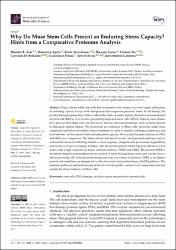Why Do Muse Stem Cells Present an Enduring Stress Capacity? Hints from a Comparative Proteome Analysis

View/
Access
info:eu-repo/semantics/openAccessDate
2021Author
Acar, Mustafa B.Aprile, Domenico
Ayaz-Guner, Serife
Guner, Huseyin
Tez, Coskun
Di Bernardo, Giovanni
Peluso, Gianfranco
Ozcan, Servet
Galderisi, Umberto
Metadata
Show full item recordAbstract
Muse cells are adult stem cells that are present in the stroma of several organs and possess an enduring capacity to cope with endogenous and exogenous genotoxic stress. In cell therapy, the peculiar biological properties of Muse cells render them a possible natural alternative to mesenchymal stromal cells (MSCs) or to in vitro-generated pluripotent stem cells (iPSCs). Indeed, some studies have proved that Muse cells can survive in adverse microenvironments, such as those present in damaged/injured tissues. We performed an evaluation of Muse cells' proteome under basic conditions and followed oxidative stress treatment in order to identify ontologies, pathways, and networks that can be related to their enduring stress capacity. We executed the same analysis on iPSCs and MSCs, as a comparison. The Muse cells are enriched in several ontologies and pathways, such as endosomal vacuolar trafficking related to stress response, ubiquitin and proteasome degradation, and reactive oxygen scavenging. In Muse cells, the protein-protein interacting network has two key nodes with a high connectivity degree and betweenness: NFKB and CRKL. The protein NFKB is an almost-ubiquitous transcription factor related to many biological processes and can also have a role in protecting cells from apoptosis during exposure to a variety of stressors. CRKL is an adaptor protein and constitutes an integral part of the stress-activated protein kinase (SAPK) pathway. The identified pathways and networks are all involved in the quality control of cell components and may explain the stress resistance of Muse cells.

















